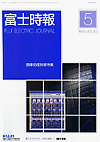FUJI ELECTRIC JOURNAL Vol.70-No.5 (May/1997)
 |
Image Processing Technique |
Trend Fuji Electric's Image Processing Technique
Michiaki Miyagawa
Fuji Electric has supplied many vision systems based on its image processing technique as automatic visual inspection equipment in various fields, which are playing an active role in the actual lines. This paper outlines the trend of user needs for vision systems and Fuji Electric's technique to meet them. The latest image processing technique has made great progress particularly in gray-level, full gray-scale, sub-pixel, ultrahigh-resolution, and high-speed processing. Relations between each processing technique and Fuji Electric's vision system FAY series are introduced.
Application of Image Processing Technique to Package and Container Inspection
Tatsuo Yamamura, Yasuharu Nakashima, Yoshio Sugiyama,
Packages and containers for products demand severe quality inspection. Fuji Electric developed the image processing system, video sensor FAY-400 series, for high-speed detection of fine defects in a mode matching the shape and surface conditions. To inspect the whole appearance with this system, TV cameras pick up images in several directions or on the devided portions. When objects require positioning control, inspection systems with an image processing system built in the conveying machine are supplied. The series has been used in various lines with good operation results.
Application of Image Processing Technique to Medical Instrument Inspection
Tatsuo Yamamura, Toshihisa Miyawaki, Kouichi Ito,
Medical instruments demand severe inspection of the whole surface to avoid quality problems. Because of their various shapes, the object is conveyed under positioning control and its whole surface is inspected with video sensor FAY-400 and cameras in several directions. Because video image appearance changes by locations and defect types on the object, inspection is made changing the decision condition to match the appearance at each divide portion. This series has shown many good operation results as high-precision inspection systems.
Sorting and Measuring Systems for Agricultural Products
Kazuhiko Fukuda, Tadashi Hiura, Hidetoshi Itoh
In the productivity improvement of agriculture and fisheries, the role of image processing technique has been increasing. Major image processing techniques in these fields are color and shape analyses, and flexible software matching various products is needed. The major applications are color and shape sorting, three-dimensional measurement, and surface inspection. Fuji Electric has developed several sorting and measuring systems for agricultural products using general-purpose color image processing unit FAY-700. This paper describes the eggplant sorting system constructed at the Minami-chikugo Agricultural Cooperative Association.
Visual Inspection Systems for Electronic and Fine-Machined Parts
Kazuhiko Fukuda, Katsumi Hosokawa, Shinji Natsume
The high-precision manufacturing of electronic and fine-machined parts require precise measurement and surface inspection. Fuji Electric has developed the gray-scale image processing equipment FAY-600 based on the high-speed gray-scale image pattern matching method. The development of high-speed LSI for normalized correlation matrix and high-precision sub-pixel interpolation techniques has attained high-precision measurement of pitch, width, length, and height, and fine-defect inspection of resin mold surfaces. This paper introduces IC lead measurement, surface defect inspection of surface mounted devices, character inspection of magnet switches.
Automated Visual Inspection System for Organic Photoconductor Drums for PPCs and Printers
Kazuhiko Fukuda, Kuniaki Yanagisawa, Akio Arai
With the growth of computer and multimedia technology, Fuji Electric has developed automated visual inspection equipment for organic photoconductor (OPC) drums for PPCs and printers. To detect surface and inner-layer defects, a high-resolution camera, high-uniformity lamp, and fine mechanism for OPC drum conveyer were developed. And, by the dedicated gray-level image processing algorithm and inspection software with high-performance workstation, the performance of point defect and gray-level nonuniformity detection exceeds human visual inspection.
Fuji Hard Disk Media Visual Inspection System
Tetsuo Kiuchi
This paper introduces the new Fuji hard disk media visual inspection system for full automated production lines. The system uses a new technology, the complex sampling method based on the physical light scattering model on a disk media surface. Target defects are scratch, stain, dimple, pit, and handling damage. Texture uniformity is also checked. The sensitivity is 20μm in size, 20nm in height, and 10 A in surface roughness. The system can inspect 900 pieces of 3.5-inch sputtered disks an hour. This in-line inspection system solves the bottleneck in manual handling in the clean room, saves labor, and improves disk media quality.
Document Reading System for Windows
Ichiro Ogura
The document reading system for Windows is used in the combination of basic software XPal-WIN, a personal computer, a Japanese document processor (optical character reader) XP-300 A for Windows, a scanner for TWAIN. Its feature is the automatic batch processing of document images in an automatic continuous recognition mode. The system can continuously read images with ADF scanner and continuously perform automatic deskewing, automatic document image segmentation (character, table, and figure segmentation), and recognition. It also has a simultaneous editing function, i.e. it can edit stored document images while reading continuously.
Application of Image Processing Technique to Road Supervisory Systems
Minoru Mukasa, Akiko Konno, Kouichi Toyama
Highway tunnels among road facilities are particularly equipped with ITV cameras at regular intervals and monitored by the staff 24 hours. This paper outlines the development of road supervisory systems which read the ITV images and carry out the measurement of the number and speed of automobiles, the detection of abnormal traveling, and the detection of dropped articles and parked cars by image processing. Also it introduces the development of visibility index (VI) meters which photograph an optical pattern with CCD camera and measure air pollution in tunnels as a transmission factor.
Video Surveillance System for Intruder Detection
Akiko Konno, Akira Shimizu,
Video surveillance systems have been widely used for security in public facilities and so on. There are growing demands for full-time surveillance without increasing the guards' burden. This paper describes a video surveillance system to detect intrusion and suspicious action by processing images from the monitoring cameras. This system can not only detect a human shape on the screen but also recognize suspicious action such as approaching, wandering and standing in the restricted area and give the alarm according to the degree of risk judged from human shape and suspicious action.

